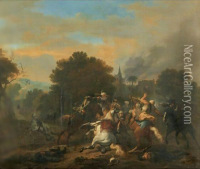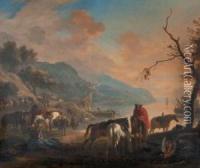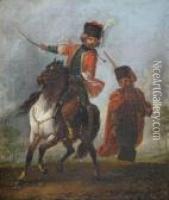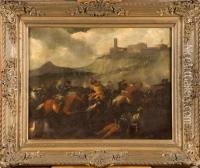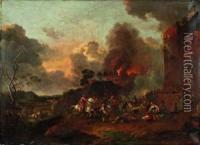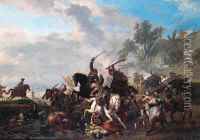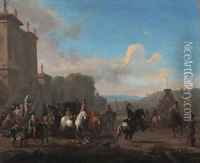Jan von Huchtenburgh Paintings
Jan van Huchtenburgh was a Dutch Golden Age painter known for his dynamic scenes of cavalry battles and skirmishes, landscapes, and animals. He was born in Haarlem in 1647, into an era when the Dutch Republic was experiencing its Golden Age, a period of great wealth, cultural achievement, and military success. Jan was initially taught by his brother, Jacob van Huchtenburgh, who was also a painter. Later on, he became a student of the renowned battle painter Jan Wyck.
Jan van Huchtenburgh's early works were influenced by the Italianate landscape painters active in Utrecht such as Jan Both and by the battle scenes of Philips Wouwerman. His style is characterized by lively and well-composed scenes filled with dramatic action and vivid detail. Around 1670, he traveled to Italy, which was a common practice among Dutch artists of the time to complete their education and to draw inspiration from the Italian masters.
While in Rome, Huchtenburgh further developed his skills and absorbed Italian influences, which can be seen in his subsequent works that feature brighter colors and a clearer light, distinct from the often more subdued Dutch palette. He became a member of the Bentvueghels, an association of mainly Dutch and Flemish artists working in Rome. It was during his Italian stay that he earned his nickname 'Giovanni d'Uccelli,' due to his skill in painting birds, which is also evident in his battle scenes where he often includes birds flying over the chaos.
Upon his return to the Netherlands, Huchtenburgh settled in Amsterdam and established himself as a successful painter. He received commissions from various patrons, including Prince Eugene of Savoy and Czar Peter the Great. His work was highly regarded for its representation of horses and the depiction of the fury of battle, capturing the chaos of war while maintaining clarity in composition.
Huchtenburgh's influence extended beyond his lifetime as he inspired other artists. His paintings often featured a combination of landscape and genre scenes, with a particular talent for depicting horses in motion. He died in Amsterdam in 1733, leaving behind a significant body of work that contributes to our understanding of the Dutch Golden Age of painting. His works can be found in numerous museums and collections around the world, reflecting his enduring legacy as a master of battle painting.
